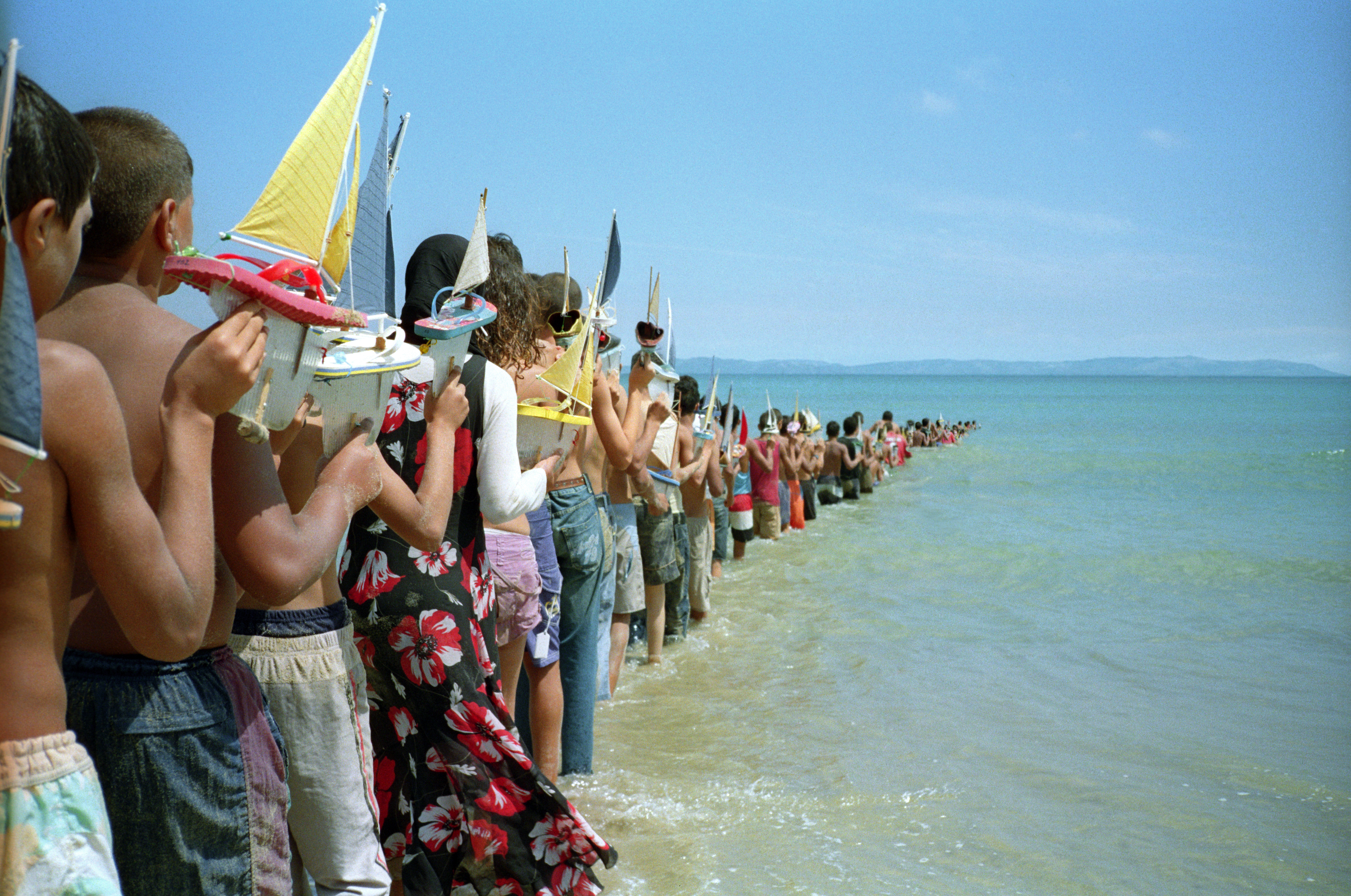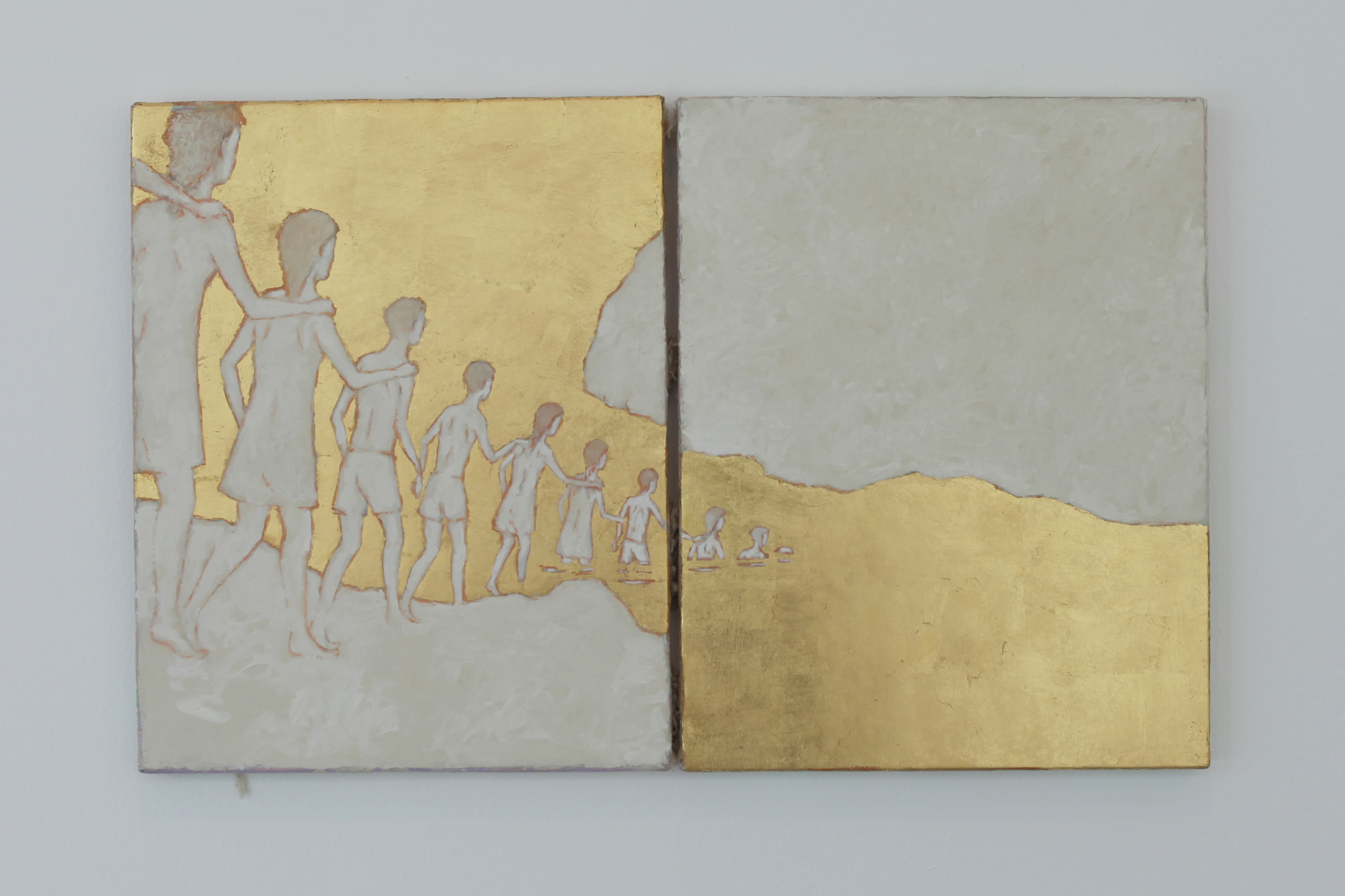Francis Alÿs discusses the unexpected circumstances during the production of his collaborative film Don't Cross the Bridge Before You Get to the River (2008).
The post Francis Alÿs: A Moment of Collective Complicity first appeared on Art21 Magazine.

Francis Alÿs, in collaboration with Julien Devaux, Felix Blume, Ivan Boccara, Abbas Benheim, Fundaciéon Montenmedio Arte, and children of Tangier and Tarifa. Don’t Cross the Bridge Before You Get to the River (Strait of Gibraltar, Morocco-Spain), 2008. Video (color, sound; 7 minutes :46 seconds). © Francis Alÿs. Courtesy the artist and David Zwirner.
Editor’s Note: Francis Alÿs discusses the unexpected circumstances during the production of his collaborative film Don’t Cross the Bridge Before You Get to the River (2008), which was shown as a part of the eleventh Sharjah Biennial. This interview was conducted by Ian Forster and Diane Vivona at the Sharjah Art Foundation in 2013. The film is available to view at the end of the text.
ART21: Please introduce us to your film, Don‘t Cross the Bridge Before You Get to the River (2008).
FRANCIS ALŸS: It’s a pretty straightforward performance piece. The idea is to create the image of a bridge in between Tarifa on the Spanish coast and Tangier on the Moroccan coast. Originally the project was meant to happen with fisherman communities on both sides and with real boats. But, because I encountered so many difficulties and problems getting the two communities involved—there’s a lot of rivalry and competition for fishing territories on the Strait of Gibraltar—the kids on both the Tangier and Tarifa sides ended up being the main partners of the project. The project is literally building two lines of boats that, to the viewer, seem to meet on the horizon. So, it’s an illusion of a meeting on the horizon line.

Francis Alÿ in collaboration with Rafael Ortega, Don’t Cross the Bridge Before You Get to the River (Strait of Gibraltar, Morocco-Spain), 2008. Installation view. Image courtesy of Sharjah Art Foundation.
ART21: What made you select this particular location?
ALŸS: Historically and geopolitically, it’s probably one of the most symbolic locations of south-to-north migrations. The Strait of Gibraltar is the way Homo sapiens crossed onto the European continent. When you’re in the Strait, you see the other side. The proximity and the kind of absurdity of movement, of the flow, is in your face.
ART21: How did you engage communities in this piece?
ALŸS: Engaging communities is the story within the story. The event is one day; it’s happening at the same time on both sides [of the Strait]. The real story of the project is the two years before the event, when we were trying to get people to engage in the conversation. That aspect is much more difficult to materialize as an artwork. In this case, I wanted to keep it the way it was: a bit like a confrontation between a fantasy of a project and the reality within the event. It includes all the problems we encountered; as it turned out, the sea was pretty rough that day. It became like a battle of the kids against the waves. But it is what it is. I put together a plot, I engaged people to participate, and then whatever happened is the answer, the response to my invitation, to my quest. I don’t think anyone ever really saw a line that reached the horizon. It could have happened another day, god knows. It’s the response I got at that particular moment.

Francis Alÿs in collaboration with Julien Devaux, Felix Blume, Ivan Boccara, Abbas Benhim, Fundación Montenmedio Arte and the kids of Tangier and Tarifa. Don’t Cross the Bridge Before You Get to the River (Strait of Gibraltar, Morocco-Spain), Video and photographic documentation of an action. Video; TRT 7 minutes 46 seconds. Photo: Roberto Rubalcava.
ART21: What was it like, working with children in stormy weather?
“That is also what I’m looking for: this moment of collective complicity”
ALŸS: I tried to step away as much as I could, to watch. At one point, I thought, “No, this is too much. This is beyond control. We need to just move out. The sea is too rough, the kids are going too far, and they’re too emotional about it.” Luckily, the sea cooled down a little bit at that point, and we carried on for another couple of hours. There was a strange moment when it was becoming something else, and the collective emotion was a bit too strong. But that is also what I’m looking for: this moment of collective complicity—a moment of extreme bumping in between the partners of the project, when everybody has the illusion that they’re making a bridge. In those moments, there is a factor of physical endurance involved in the project.
But sometimes you have to be able to say, “That’s the limit.” And we reached that point. Working with kids who are the age of my son, I felt very awkward afterward. The event was more dangerous than it looks. The kids weren’t standing on the ground at the end of the line; they were swimming. In a normal sea, that would be okay, but the conditions on that particular day were beyond normal; I didn’t know if those kids could swim. [After filming,] we made a call on the beach—“Who wants to have a boat?”—because we were leaving the boats [there]. The piece also includes making a meal, like a fiesta or a party, and creating a moment when the community comes together and thinks about this one particular issue.
“I’m a spectator as much as you are.”
ART21: How did you go about depicting this situation on film?
ALŸS: I was trying to write a chronicle of the project, and I realized there’s no happy ending. There’s no moral, just presenting facts and a state of tension between two coasts—in this case, two communities and two cultures—and the rest is as open as can be.

Francis Alÿ in collaboration with Rafael Ortega, Don’t Cross the Bridge Before You Get to the River (Strait of Gibraltar, Morocco-Spain), 2008. Installation view. Image courtesy of Sharjah Art Foundation.
ART21: How do you view the finished piece?
ALŸS: Retrospectively. The piece was performed in 2008, but I started working on the project in 2006. I kept it in the closet for years because I didn’t know how to tell the story. And then, suddenly, I started writing. It was a slightly conflictive project for me to work on. Through that process, I decided that it’s okay to show it for what it is. My perception of the project today is unclear. I’m starting to get a few reactions now. Today, while I was mounting the exhibition, an Indian or Pakistani worker came to me and said, “I understood that part, but what were you trying to say there?” I come here to look for answers, as much as the public does. When I put a work on the stage, it’s not mine anymore. I’m a spectator as much as you are.
Visit the artist’s website for more information about the film and Sharjah Art Foundation for insight and images about the entire installation.
The post Francis Alÿs: A Moment of Collective Complicity first appeared on Art21 Magazine.
